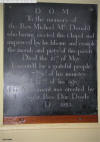-

- Holy Cross Church,
Killeshin
- Photo by W. Muldowney
|
-

- Plaque
-
Photo by Carloman
|
-

- Holy Cross Church, Killeshin.
- Photo by
Chris 'Joe' O'Brien
|
-

- Holy Cross Church, Killeshin
-
Photo by W. Muldowney
|
-

- Memorial
|
-

- Memorial
|
-

- Old Church
|
-

- Old Church
|
-

- Memorial
|
-

- Memorial
|
- Killeshin as described in the
- Topographical Dictionary of Ireland,
- by Samuel Lewis in 1837
KILLESHIN, a parish, in the barony of SLIEUMARGUE,
QUEEN'S county, and province of LEINSTER; containing, with a part
of the suburbs of Carlow, called Graigue, 5152 inhabitants. It
comprises 10,529 statute acres, as applotted under the tithe act,
and valued at £7765 per annum; and, with the exception of about 40
acres of Woodlands and 200 of bog, consists of arable and pasture
land: the agriculture is good; and the mountains, which rise 1000
feet above the river Barrow, are cultivated to their summits.
Sandstone and limestone are found here, and extensive collieries
are worked by H. Fitzmaurice, Esq. There were formerly
smelting-furnaces, which were discontinued for want of fuel. The
principal seats are Springhill, the residence of -- Laforell,
Esq.; and Ardcleagh, of H. Fitzmaurice, Esq.
The living is a
rectory and vicarage, in the diocese of Leighlin; the rectory is
in the patronage of the Crown, and the vicarage in that of the
Bishop, but they are held by one incumbent; the tithes amount to
£461. 10. 9 1/4. The church is modern and has an arched stone
roof, like St. Keirn's chapel at Glendalough's and those of St.
Cormac at Cashel and St. Doulough near Dublin: the Ecclesiastical
Commissioners have lately granted £131 for its repair. In the R.
C. divisions this parish is the head of a union or district,
comprising also the parish of Slatey, and has chapels at Graigue
and Killeshin, the latter of which stands on an artificial mound
and has octagon towers at the corners.
About 270 children are
educated in three public, and about 150 in six private schools.
Here is a very strong chalybeate spring, which was formerly in
high repute. The ruins of the ancient parish church have an
ornamented entrance, which is encircled with an illegible
inscription in ancient Irish characters; and near it is the site
of an ancient round tower, also the remarkable "Cut of Killeshin,"
which is a pass on the road from Carlow to the collieries, carried
through a lofty hill for more than half a mile, and from 10 to 40
feet deep and 21 wide. Within the parish are some ruins which seem
to be the foundations of the public buildings of an ancient town.
At Old Derig was the residence of Dr. James Doyle, R. C. bishop of
Kildare and Leighlin, where his letters signed J. K. L. were
written..
Source:
www.LibraryIreland.com
Oisin Park & House

A Dancing Board & House Dancing tradition in the Rossmore/
Killeshin area dates back some considerable time. Up until the
advent of World War 1 the tradition was strong. In 1927 the coal
miners organised dances at the crossroads and the tradition is
still carried on here every Sunday afternoon during the summer.
This Park is operated by Rossmore Killeshin Development
Association and in 1999 they opened a rural conference centre.
This park is situated at over 1000ft above sea level and it offers
panoramic views of the Barrow Valley below which are bordered
magnificently by the Wicklow & Blackstairs Mountains. In the far
distance the Dublin Mountains are visible. The night time view of
Carlow Town is impressive.
Source:
http://homepage.eircom.net/
|